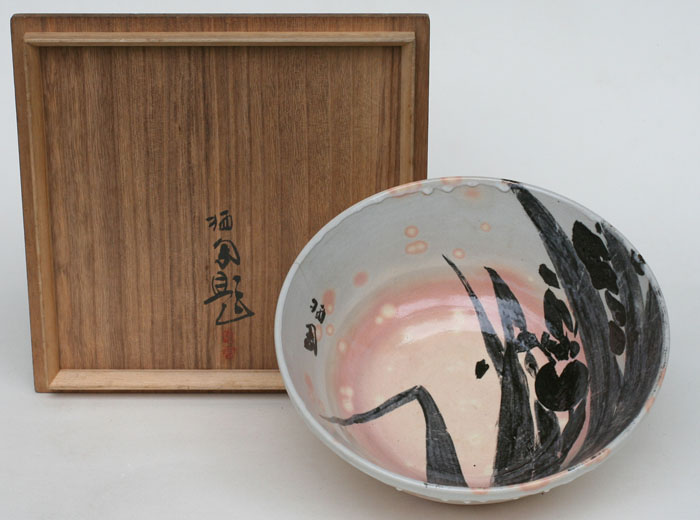Kyôyaki
Kashibachi, Cake bowl - Kakitsubata, IrisSigned: Seihô
Seals: Kiyo
Technique: Grey gohonde kyôyaki with dripping slip and a black tetsu-e underglaze decoration Ø 22,3 x 9,1
Date: 1919-20
Box: signed
Condition: A stress crack (baking flaw) in the rim, otherwise very good
Seihô was one of the last very important and famous Maruyama-Shijô style painters.
He was an extremely skilful painter, which earned him fame and a lot of pupils. He entered Bairei's studio at the age of 16 and already in the following year he won his first prize at an exhibition, which is a rare for such a young artist.
He eagerly studied all different styles. In 1900 he went to Europe for six months to get acquainted with western painting. On his return he changed the first character "Sei" of his name into a character meaning "West". His two trips to China in 1920 and 1921 meant another enrichment to his painting. His flexibility in styles and the flamboyantly virtuoso way he handled his brush meant in the eyes of some critics that his craftsmanship reduced his artistic abilities.
Reference:
Next to a number of monographs and in any general book on modern Japanese painting:
Harada 1981
Berry & Morioka ‘99 pp. 130-137
Conant pp. 322-323
Roberts p. 171
Araki p. 1633
Rokubei V, the second son of Kiyomizu Rokubei IV, studied Shijô painting with Kôno Barei (1844-1895) and also at the Kyoto Prefectural School of Painting. After his graduation he studied ceramic techniques with his father and glazing techniques at the Kyoto Municipal Ceramic Laboratory. He worked on the research of new glazing techniques and western designs. When Rokubei IV retired in 1913, he inherited the title and became Rokubei V. He exhibited at the Nôten, the Design and Applied Artworks Exhibition sponsored by the Ministry of Agriculture and Commerce, and at the Teiten, the Imperial Art Academy Exhibition. He also became a member of the Imperial Art Academy and played an important role as a leading figure of the craft world. In 1945 he retired.
Reference:
Kyoto ‘03, ’Sekka’ p. 326 ff.
Price: SOLD

